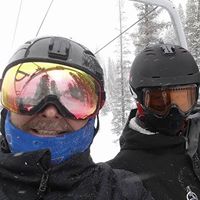John C Isenberg
Deceased
from Clearwater, FL
- Also known as:
-
- John Lollis
- Jean Isenberg
- Jeanie Isenberg
- Jeannie Isenberg
- Jean I Eisenberg
John Isenberg Phones & Addresses
- Clearwater, FL
- Terre Haute, IN
- 112 Bayview Dr, Mooresville, NC 28117 • 7047990088
- Indianapolis, IN
- Holland, OH
Resumes

John Isenberg
view source
John Isenberg
view source
John Isenberg
view sourceName / Title
Company / Classification
Phones & Addresses
Principal
Isenberg Enterprises
Business Services at Non-Commercial Site
Business Services at Non-Commercial Site
5234 Mann Rd, Indianapolis, IN 46221
Principal
Fit & Trim Inc
Business Services at Non-Commercial Site
Business Services at Non-Commercial Site
721 Mitchell Ave, Salisbury, NC 28144
Us Patents
-
Method Of Attaching A Flip Chip Device And Circuit Assembly Formed Thereby
view source -
US Patent:7038321, May 2, 2006
-
Filed:Apr 29, 2005
-
Appl. No.:10/908162
-
Inventors:Abhijeet V. Chavan - Carmel IN, US
Jeffrey A. Mars - Kokomo IN, US
Ian D. Jay - Logansport IN, US
Johnna L. Wyant - Kokomo IN, US
David W. Ihms - Russiaville IN, US
John K. Isenberg - Rossville IN, US
Roger E. Worl - Russiaville IN, US -
Assignee:Delphi Technologies, Inc. - Troy MI
-
International Classification:H01L 23/52
H01L 23/48
H01L 29/40 -
US Classification:257778, 257678, 257414, 257415, 257728, 257782, 257786, 438124, 438126, 438127, 310313 R, 310340, 361772
-
Abstract:A method of flip-chip mounting a circuit device to a substrate in a manner that avoids damage and impairment of a fragile or otherwise sensitive element on the device facing the substrate, and a circuit assembly produced thereby. The assembly includes a substrate having at least two sets of bonding sites spaced apart from each other to define an intermediate surface region therebetween. The device is attached to the bonding sites with solder connections, with the solder connections being present on a surface of the device that faces the substrate and on which the element is present so that the element overlies the intermediate surface region of the substrate. An underfill material is present between the device and the substrate and encapsulates the solder connections. The underfill material is separated from the intermediate surface region of the substrate so that the underfill material does not contact the element.
-
Multiple Hydraulic Circuit Pressure Sensor
view source -
US Patent:20130036826, Feb 14, 2013
-
Filed:Jun 3, 2011
-
Appl. No.:13/695170
-
Inventors:Daniel R. Dahlgren - Cicero IN, US
Daniel A. Lawlyes - Kokomo IN, US
Markus Naegeli - Kokomo IN, US
John K. Isenberg - Rossville IN, US
Lewis Henry Little - Peru IN, US -
Assignee:DELPHI TECHNOLOGIES, INC. - TROY MI
-
International Classification:G01L 9/04
G01L 9/02 -
US Classification:73720, 73719
-
Abstract:A hydraulic solenoid assembly for complex vehicle-borne control systems, such as automatic transmissions, includes a solenoid body or unitary housing operatively enclosing two or more solenoid valves. Each valve has a pressure port extending to an outer surface of the housing, emerging in a spaced-apart matrix. A metal (stainless steel or aluminum) sensor plate is mounted to the outer surface of the housing so as to sealingly overlay the pressure ports. A diaphragm is formed in the sensor plate for each solenoid valve and registers with its associated pressure port. Electrical components, such as thick file resistors arranged in a Wheatstone bridge network are printed or mounted to an outer surface of each diaphragm. The bridge networks are electrically connected to a control circuit and function to output signals as a function of hydraulic pressure induced displacement of the associated diaphragm.
-
Thick-Film Paste With Insoluble Additive
view source -
US Patent:63289148, Dec 11, 2001
-
Filed:Jan 29, 1999
-
Appl. No.:9/240084
-
Inventors:Frans Peter Lautzenhiser - Noblesville IN
Carl William Berlin - West Lafayette IN
Bradley Howard Carter - Kokomo IN
John Karl Isenberg - Rossville IN -
Assignee:Delphi Technologies, Inc. - Troy MI
-
International Classification:H01B 106
H01C 106 -
US Classification:252510
-
Abstract:A thick-film paste for printing thick-film circuit elements, including solder stops, conductors, resistors and capacitors, and a method for using the paste. The paste has a composition that includes an organic vehicle, a filler material that contributes the desired electrical and/or material properties to the thick film fired from the paste, and an additive that is insoluble in the organic vehicle and contributes pseudoplastic Theological properties to the paste during printing. The additive also preferably evaporates, burns off, sublimates or is otherwise removed below the firing temperature of the paste.
-
Method Of Manufacturing A Thick Film Circuit With Constrained Adhesive Spreading
view source -
US Patent:61645222, Dec 26, 2000
-
Filed:Aug 27, 1999
-
Appl. No.:9/384892
-
Inventors:Frans Peter Lautzenhiser - Noblesville IN
John Karl Isenberg - Rossville IN -
Assignee:Delphi Technologies, Inc. - Troy MI
-
International Classification:B05D 512
B23K 3102 -
US Classification:228175
-
Abstract:An improved method of manufacturing thick film circuit wherein an IC is attached to a central conductor pad with adhesive, and wherein spreading of the adhesive is constrained by a ring of porous dielectric material formed between the central conductor pad and the peripheral conductor pads to which the IC terminals are bonded. When the adhesive material is printed and begins to spread, it contacts the porous dielectric ring, which absorbs the adhesive material and stops the spreading. In this way, the porous dielectric ring controls the dimensions of the cured adhesive, thereby preventing the adhesive from contaminating the peripheral conductor pads. Even with the addition of the intervening dielectric ring, the length of the wire-bond connections and the overall dimension of the IC and its conductor pads are both significantly decreased, contributing to improved circuit area utilization and wire-bond durability.
-
Method Of Manufacture For A Thick Film Multi-Layer Circuit
view source -
US Patent:59103345, Jun 8, 1999
-
Filed:Dec 16, 1997
-
Appl. No.:8/991685
-
Inventors:Frans Peter Lautzenhiser - Noblesville IN
John Karl Isenberg - Rossville IN
James Edward Walsh - W. Lafayette IN
Adam Wade Schubring - Kokomo IN -
Assignee:Delco Electronics Corporation - Kokomo IN
-
International Classification:B05D 512
-
US Classification:427 96
-
Abstract:An improved method of manufacturing multi-layer thick film circuits that effectively eliminates the trade-off between thickness and definition, permitting dielectric layers of increased thickness with no pin-holes, and at the same time, more precise definition of dielectric features, such as via openings and solder stops. The dielectric features are precisely defined by an initial thin layer of dielectric material, referred to as a feature definition print, or FDP. After the FDP has been dried but not yet fired, a via can be formed by printing a comparatively thick cover layer of dielectric, over-lapping the edges of the FDP. Due to the porous nature of the dried but not fired FDP, it absorbs solvent from the dielectric cover layer, which inhibits the spreading of the dielectric cover layer. The FDP is then co-fired with the first dielectric layer, and a second dielectric layer may be provided atop the fired first layer to further increase the overall dielectric thickness, if so desired. This results in a thicker dielectric layer for the same number of successive printing steps, and at the same time, smaller dielectric features.

John Isenberg
view source
John Isenberg
view source
John Isenberg
view source
John Isenberg
view source
John Isenberg
view source
John Isenberg
view source
John Isenberg
view source
John Isenberg
view sourceFlickr
Classmates

John Isenberg
view sourceSchools:
Coleman High School Coleman OK 1969-1973
Community:
Earnie Dean, Rhonda Layton, Delores Golden, Gwendylen Dooley, Tony Tipton, Dan Pannell, Rhonda Dean, Robin Layton, Linda Workman, Allen Mcdaniel, Nancy Dean

John Isenberg, Boyden Hig...
view source
Coleman High School, Cole...
view sourceGraduates:
John Isenberg (1969-1973),
Donna Cook (1976-1980),
Shelly Watson (1992-1996),
Jimmy McDaniel (1979-1983),
Bob Noone (1989-1993),
Sam Smith (1998-2002)
Donna Cook (1976-1980),
Shelly Watson (1992-1996),
Jimmy McDaniel (1979-1983),
Bob Noone (1989-1993),
Sam Smith (1998-2002)

Boyden High School, Salis...
view sourceGraduates:
Mary Morris (1961-1965),
Geraldine Yarborough (1964-1968),
John John Isenberg (1958-1962),
Faye Hunt (1966-1970),
Ethel Lee Yates (1952-1956)
Geraldine Yarborough (1964-1968),
John John Isenberg (1958-1962),
Faye Hunt (1966-1970),
Ethel Lee Yates (1952-1956)
Myspace
Youtube
Get Report for John C Isenberg from Clearwater, FLDeceased













